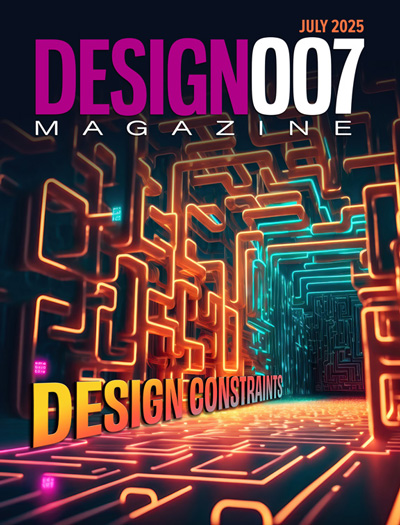-

- News
- Books
Featured Books
- design007 Magazine
Latest Issues
Current Issue
Signal Integrity
If you don’t have signal integrity problems now, you will eventually. This month, our expert contributors share a variety of SI techniques that can help designers avoid ground bounce, crosstalk, parasitic issues, and much more.

Proper Floor Planning
Floor planning decisions can make or break performance, manufacturability, and timelines. This month’s contributors weigh in with their best practices for proper floor planning and specific strategies to get it right.

Showing Some Constraint
A strong design constraint strategy carefully balances a wide range of electrical and manufacturing trade-offs. This month, we explore the key requirements, common challenges, and best practices behind building an effective constraint strategy.
- Articles
- Columns
- Links
- Media kit
||| MENU - design007 Magazine
HDI, A-SAP and mSAP: A Designer’s Point of View
October 26, 2022 | Cherie Litson, CID+, Litson1 ConsultingEstimated reading time: 1 minute
HDI—high-density interconnect—designs require some different thinking on the part of the designer. One of the first things to consider is whether you need HDI, and if so, how much. The HDI option comes into play as soon as you purchase any components with 0.5 mm pin pitch.
The number of these components and other specifications of your design will determine the amount of HDI you will need. Each option brings choices that will affect fabrication and assembly, so a little research is needed before making these choices. Here’s a quick list of HDI options:
- Smaller vias
- Smaller traces
- Thinner dielectrics
- Tighter solder mask clearances
- Controlled paste mask construction
I’m only going to explore the first two, as these often determine which fabrication process you want to use.
Smaller Vias
A variety of options are available here:
Blind vias with through vias
This is the optimal choice. It adds a little expense while giving you the ability to place components on both sides of the board without having to be confined by opposing pad with different nets.
Blind and buried vias with through vias
This option gives you the most routing control; however, it also adds the most cost.
Through vias only
While this can cut fabrication costs, it limits breakout, routing, via size, and component placement. Smaller vias are dependent upon the aspect ratio of the board. Keep the board thin and most fabricators can produce smaller vias, down to 6 mils (1.5 mm) if your board measures 50 mils of thickness or less, without additional costs.
Both the A-SAP and mSAP processes can be used to plate holes. Again, the aspect ratio will make a difference. Also, how much plating do you need? Are you plugging the vias with conductive or non-conductive material?
Smaller Traces
How small you will go depends on the fabrication process you select and how small the component pin pitch is.
It’s important to understand the differences between A-SAP and mSAP before you commit to a process. Standard subtractive etch processes start with very thin copper foils, etch a pattern, and then add copper for the finished traces and copper features.
To read this entire article, which appeared in the October 2022 issue of Design007 Magazine, click here.
Testimonial
"The I-Connect007 team is outstanding—kind, responsive, and a true marketing partner. Their design team created fresh, eye-catching ads, and their editorial support polished our content to let our brand shine. Thank you all! "
Sweeney Ng - CEE PCBSuggested Items
Koh Young, Fuji, and Kurtz ERSA Drive Smart Manufacturing Solutions for EV and Automotive Electronics at Kunshan, China Technical Seminar
09/11/2025 | Koh YoungKoh Young Technology, the global leader in True 3D measurement-based inspection solutions, partnered with Fuji Corporation and Kurtz ERSA to host an exclusive technical seminar for leading automotive manufacturers in East China. Held on September 4 at Fuji’s factory in Kunshan, the event gathered participants representing over 35 companies.
MacDermid Alpha Presents at SMTA New Delhi, Bangalore Chapter, on Flux–OSP Interaction
09/09/2025 | MacDermid Alpha Electronics SolutionsMacDermid Alpha contributes technical insights on OSP solderability at the Bangalore Chapter, SMTA reinforcing commitment to knowledge-sharing and industry collaboration.
Electra’s ElectraJet EMJ110 Inkjet Soldermask Now in Black & Blue at Sunrise Electronics
09/08/2025 | Electra Polymers LtdFollowing the successful deployment of Electra’s Green EMJ110 Inkjet Soldermask on KLA’s Orbotech Neos™ platform at Sunrise Electronics in Elk Grove Village, Illinois, production has now moved beyond green.
Absolute EMS: The Science of the Perfect Solder Joint
09/05/2025 | Absolute EMS, Inc.Absolute EMS, Inc., a six-time award-winning provider of fast turnaround, turnkey contract electronic manufacturing services (EMS), is drawing attention to the critical role of 3D Solder Paste Inspection (SPI) in ensuring the reliability of both FLEX and rigid printed circuit board assemblies (PCBAs).
Indium Corporation to Highlight High-Reliability Solder Solutions at SMTA Guadalajara Expo
09/04/2025 | Indium CorporationIndium Corporation, a leading materials refiner, smelter, manufacturer, and supplier to the global electronics, semiconductor, thin-film, and thermal management markets, will feature a range of innovative, high-reliability solder products for printed circuit board assembly (PCBA) at the SMTA Guadalajara Expo and Tech Forum, to be held September 17-18 in Guadalajara, Mexico.


